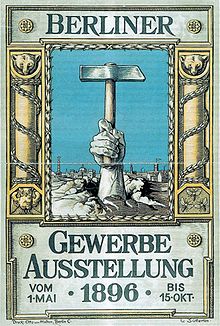Hotel Buchholz
Hotel Buchholz is a novel by Julius Stinde that was published in Berlin in 1897 by Freund & Jeckel. It describes the Berlin trade exhibition of 1896 from the perspective of the petty bourgeois woman Wilhelmine Buchholz .
Stinde was asked by Alfred Holzbock , the editor of the “Official Exhibition News” published by August Scherl , to provide reports on the trade exhibition “calculated for middle families” under the bogus authorship of the petty bourgeois woman Wilhelmine Buchholz from Berlin. Stinde's conditions under which he accepted this assignment are recorded in a letter to Alfred Holzbock dated March 29, 1896 ( Berlin State Library , Holzbock estate). This letter is printed in a collection of letters from Stinde to publishers, editors and editors. It says, among other things:
"The suspended fee of 1200 (twelve hundred marks) is in view of the fees as they are paid to me, not a brilliant one, but since I reserve the right to publish the feature pages after the exhibition has ended, I can accept your suggestion if further some relief occurs which is to be regarded as an equivalent for the intimate study of the exhibition. The preparatory work for the articles takes more time than it takes to prepare them. The publisher will provide me with an admission ticket - press ticket - as well as admission to special exhibition festivities, on the occasion of which I must be allowed to liquidate personal expenses, of course only if Ms. W. Buchholz informs about the festivities and the like. similar reports. "
From these articles, Stinde created his book “ Hotel Buchholz. Exhibition experiences of Mrs. Wilhelmine Buchholz. Edited by Julius Stinde ”. The book begins with a description of the domestic problems that arise for Ms. Wilhelmine by accepting this assignment, which gives the author the opportunity to revive the staff tried and tested in six previous Buchholz books (aged by the appropriate number of years) let: the narrator herself, her husband Karl, her brother Fritz, the now married daughters Emmi and Betti and the intimate enemies Frau Bergfeldt, who has now become Frau Butsch through the death of her husband and remarriage, and the Krausen. On her first sightseeing excursion with neighbors, Ms. Buchholz takes the opportunity to take a first look around the buildings, their location and furnishings by assessing everything from her practical housewife point of view.
“The sea, in the background with the white water tower and the main restaurant, in front the fields of flowers, the obelisks and music from the pavilions, that was really beautiful. And then, by simply turning the human body, the view of the industrial building with the dome and the towers, whose aluminum caps shone in the sun like brand-new soup pots and the orange trees on the roof of the porch, which ends in two wall halls. . . "
As an experienced playwright, Stinde knows that there can be no reading tension without complications. That is why Wilhelmine gets the "daughter of a half-cousin", Ottilie by name, "because she has been examined for oxygen, spectralism, electroplating and all other newer educational aids" to assist with writing about the technical-scientific aspects of the exhibition. She also subscribes to the architect Krieberg, who is supposed to help her with the description of the buildings. The book has additional staff from visitors who come to stay at the Buchholzens from far away to see the Treptower exhibition: Ungermanns, Kliebischs (travel acquaintance from Buchholzens in Italy ), Aunt Lina, an old maid, and the magistrate, a lively cousin of Mr. Buchholz . Each person brings their own storyline and storyline into the book, and Stinde knows how to use it to compose a themed whole with dramatic climaxes without neglecting the description of the exhibition and its sights.
In the sixth chapter Wilhelmine gets an overview of the whole thing and recognizes a boot jack in the design of the main industrial building, a bass violin in the Neuer See and a fish figure in the carp pond. The painter Richard Knötel captured Wilhelmine's impressions congenially.
Separate chapters are devoted to the festival of light, machines, architecture, continuous rain, the artificial Alps, the reconstructed old Berlin and the topic of “Spree Africa”, and further details are inserted between the dramatic entanglements. Karl Buchholz also exhibits the products of his small knitwear factory. Unfortunately, the editor of the Official Exhibition News is crossing out this passage from Wilhelmine's manuscript and, of all people, she gives the manuscript to the envious Frau Krause to read, who reads it out loud, including the editor's comment:
“The highlight of the entire exhibition, as has never been there before and will attract the eyes of the nations, is located on the left in the main building. It is an imperial eagle artistically produced from diamond black stockings on a white ground, absolutely colourfast and washable with reinforced toes and heels under guarantee, a large part of the qualities also with reinforced soles a model achievement of the house Buchholz und Sohn. "
Web links
- Hotel Buchholz in the Internet Archive



